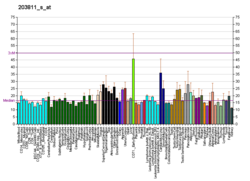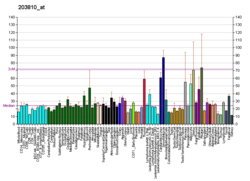| DNAJB4 |
|---|
|
| Identifiers |
|---|
| Aliases | DNAJB4, DNAJW, DjB4, HLJ1, DnaJ heat shock protein family (Hsp40) member B4 |
|---|
| External IDs | OMIM: 611327; MGI: 1914285; HomoloGene: 100610; GeneCards: DNAJB4; OMA:DNAJB4 - orthologs |
|---|
| Gene location (Human) |
|---|
 | | Chr. | Chromosome 1 (human)[1] |
|---|
| | Band | 1p31.1 | Start | 77,979,175 bp[1] |
|---|
| End | 78,017,964 bp[1] |
|---|
|
| Gene location (Mouse) |
|---|
 | | Chr. | Chromosome 3 (mouse)[2] |
|---|
| | Band | 3|3 H3 | Start | 151,884,148 bp[2] |
|---|
| End | 151,915,939 bp[2] |
|---|
|
| RNA expression pattern |
|---|
| Bgee | | Human | Mouse (ortholog) |
|---|
| Top expressed in | - Skeletal muscle tissue of rectus abdominis
- Achilles tendon
- Skeletal muscle tissue of biceps brachii
- muscle of thigh
- right ventricle
- thoracic diaphragm
- tail of epididymis
- myocardium
- vena cava
- right coronary artery
|
| | Top expressed in | - ascending aorta
- aortic valve
- secondary oocyte
- zygote
- seminiferous tubule
- primary oocyte
- atrioventricular valve
- spermatid
- intercostal muscle
- tunica media of zone of aorta
|
| | More reference expression data |
|
|---|
| BioGPS | 
 | | More reference expression data |
|
|---|
|
| Gene ontology |
|---|
| Molecular function | - unfolded protein binding
- chaperone binding
- protein binding
- ATPase activator activity
| | Cellular component | - cytosol
- membrane
- cytoplasm
- nucleoplasm
- plasma membrane
| | Biological process | - response to unfolded protein
- response to heat
- protein folding
- positive regulation of ATP-dependent activity
- negative regulation of transcription by RNA polymerase II
- chaperone cofactor-dependent protein refolding
| | Sources:Amigo / QuickGO |
|
| Orthologs |
|---|
| Species | Human | Mouse |
|---|
| Entrez | | |
|---|
| Ensembl | | |
|---|
| UniProt | | |
|---|
| RefSeq (mRNA) | NM_007034
NM_001317099
NM_001317100
NM_001317101
NM_001317102
|
|---|
NM_001317103 |
| |
|---|
NM_025926
NM_027287
NM_001356363
NM_001356364 |
|
|---|
| RefSeq (protein) | NP_001304028
NP_001304029
NP_001304030
NP_001304031
NP_001304032
|
|---|
NP_008965 |
| |
|---|
NP_080202
NP_081563
NP_001343292
NP_001343293 |
|
|---|
| Location (UCSC) | Chr 1: 77.98 – 78.02 Mb | Chr 3: 151.88 – 151.92 Mb |
|---|
| PubMed search | [3] | [4] |
|---|
|
| Wikidata |
| View/Edit Human | View/Edit Mouse |
|


















